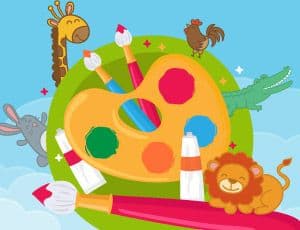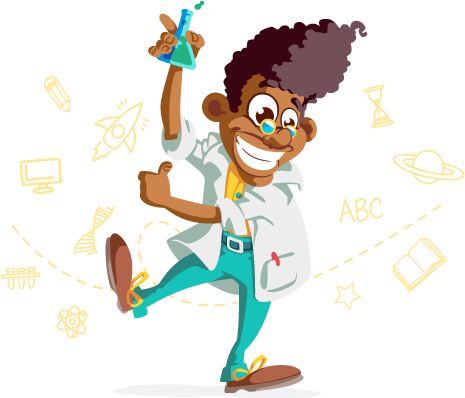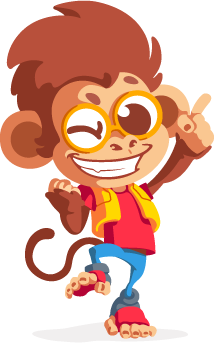Escola Games | Jogos Educativos
https://www.escolagames.com.br
Teacher's support sheet

Time to Paint Animals
Hi there, mate! Lets make the animals colorful. You can paint an elephant, rabbit, tiger, and several others! Show your creativity and all your artistic skills!

Teacher's tips
Level of Education: Elementary School - Preschool
Subject: Art
Theme: Artistic expression
Age: 04 to 06 years
Art is a form of expressing what happens in a child's life. It is the first way children talk about their world, show their feelings, and develop their motor skills. It is possible to insert visual arts in early childhood education through photos, paintings, theaters, and drawings. Traditional teaching focused only on fragmented content does not explore the full power of art in early childhood education and its role in shaping citizens' awareness of their role in society. The teacher must adapt these activities to go through the playful stage and then improve and deepen them according to the age group and school grade. [FIM-DICA]
Learner outcomes
To widen their general knowledge through the manipulation of different colors, shapes, and painting techniques;
To get in touch with various forms of artistic expression;
To develop and stimulate attention, reasoning, and concentration;
To evolve body control and motor coordination;
To be able to express themselves better;
To develop emotional intelligence and creativity.
Teachers' goals
To explore activities that use various artistic languages, considering the multidisciplinary content of this stage;
To awaken students' interest in learning arts and English;
To reinforce content discussed during the classes.
Suggestions of approaches for the teacher
(Approach 1) Use a string to make A4 sheet drawings and ask students to paint the spaces delimited by the line.
(Approach 2) Hand panel: Ask children to paint their hands with the colors they want and mark the cardboard, like a stamp. Their hands painted on the cardboard will amuse them.
(Approach 2) Print shapes/drawings and ask students to color them. Use gouache paint, crayons, glue with glitter, and coloring pencils, among other features.
(Approach 4) Apply the content in different classroom environments to show that art can be present everywhere.
(Approach 5) Provide experiences that educate through art, using the references children bring from their experience inside and outside the school environment.
(Approach 6) Set up exhibitions with drawings and paintings of the students.
(Approach 7) Plan a monthly mural in the classroom. Every month students choose an animal group and make paintings of it.
(Approach 8) Encourage students to produce different artistic works, such as drawing, modeling, clipping, collage, and children's painting.
(Approach 9) Produce self-portrait paintings.
(Approach 10) Organize a photo or drawing contest.
(Approach 11) Using transparent cups, mix water and food coloring of different colors to teach students about them.
(Approach 12) Promote artistic creations using recycled material.
(Approach 13) Make paintings on cardboard using brushes, sequins, glitter, and other texturized materials.
More about the content
5 Reasons Why Art is Important for Early Childhood Development
Studies show students who study art are four times more likely to be recognized for academic achievement and three times more likely to be awarded for school attendance. In fact, countries that consistently score highest in math and the sciences have mandatory art classes in schools.
In early childhood development, art benefits children in a variety of ways, such as:
- Motor Skills
When kids participate in creating arts and crafts, there are many movements involved. From holding a paintbrush to coloring with a crayon, a child's fine motor skills progress through this hands-on approach to education. Other actions, such as using scissors, help develop the dexterity children need for writing.
- Language Development
In addition to getting their hands physically dirty creating art, children have the opportunity to expand their vocabulary by learning words for colors, shapes, and various actions. This helps children use descriptive words to discuss their creations and will help them express what feelings are elicited from observing different types of art by the time they are in elementary school.
- Decision-Making
Studies show art education strengthens both critical-thinking and problem-solving skills in young children. The process of creating art gives children choices and urges them to make decisions in the course of creating their art - a crucial skill that translates into other parts of life. For example, exploration through art will encourage children to try new ideas in other areas of life. Not only will this further spark creativity and imagination, but children also use critical thinking to react to new experiences and problem-solve when necessary.
- Cultural Awareness
Exposing children to a variety of interpretations of society is a great way to help them understand the nuances of their surroundings and embrace the differences they see around them in the diverse society we live in today.
- Encourages Neural Connections
Because art employs any or all of the senses, such as sight, sound, taste, and smell, the synapses in the brain of a small child fire away as they experience situations that immerse their senses and further encourage their creativity. In fact, a young brain makes billions of new connections with every bit of new knowledge it is exposed to. In young children, artistic activities lead to the formation of well-rounded personalities, good attachment, self-esteem, and better mental health.
Source: https://kidcreate.com/blog?post=art-importance-in-child-development
